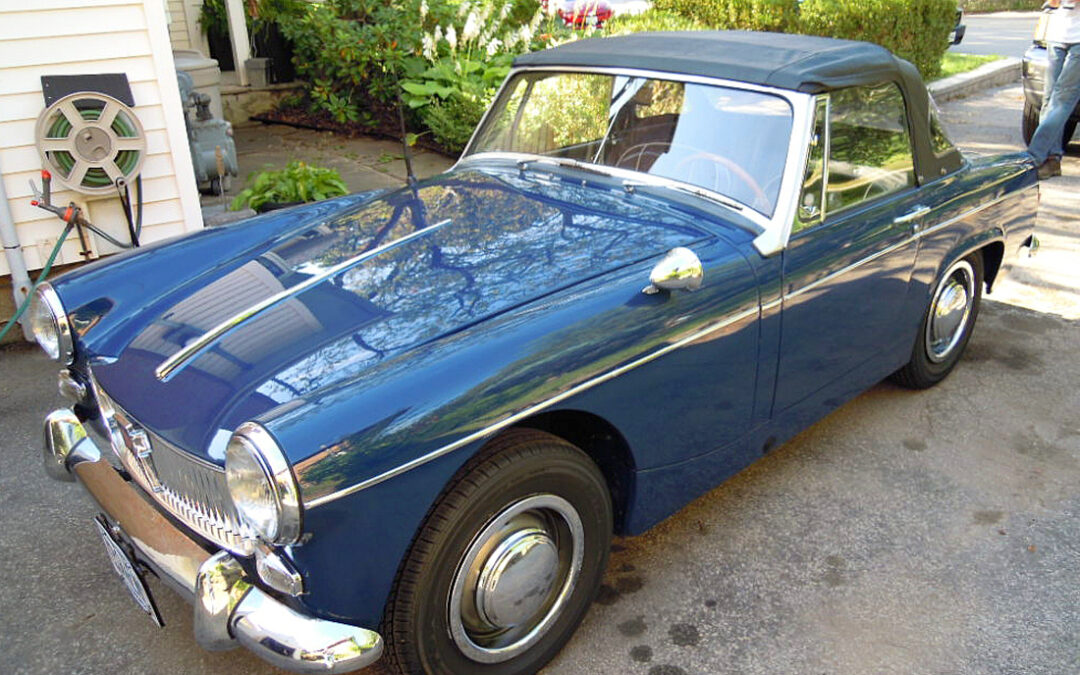Burlington, Ontario
As a baby boomer, I was in my early teens when both of my “much” older brothers started buying cars.
One went with British sports cars, the first being an early 1960s Austin Healey, (Frog-Eyed if British, Bug-Eyed if North American), Sprite.
The Austin-Healey Sprite, designed by the Donald Healey Motor Company, is a small open sports car which was produced in the United Kingdom from 1958 to 1971. The Bug-Eye was officially known as the Mark 1 and had been introduced specifically to fill the gap in the market left by the end of production of the MG T-type Midget.
Its replacement, the MGA, had been a significantly larger and more expensive car with greater performance.
The Bug-Eye was very rudimentary, no door handles or locks, and when it rained, chances were you got just as wet inside, as out. This didn’t impress his girlfriend at the time, although, she did marry him. I also remember after turning a corner you had to return the steering wheel to centre manually.
In the mid-1960s he moved up to pure luxury, a brand new MGB. Imagine the power, the roll-up windows, and a roof that kept you close to dry when it rained.
Dad was a truck driver that believed in teaching his sons how to drive as early as possible, including his Semi with 18 gears. I wasn’t 16 or licensed yet, but, was allowed to drive cars on the country roads up at our cottage in the Bruce Peninsula. If mom had to go to the general store, Den would allow me to chauffeur her in his MGB.
Looking at the history of MG, from 1924, Cecil Kimber of Morris Garages, Oxford, had been assembling sporting versions of the Morris Oxford. This enterprise prospered so well that a separate M.G. Car Company was formed, with its plant at Abingdon-on-Thames.
MG began using the Midget name at the end of the 1920s. They continued to use the label on the T-Series cars into the mid-1950s. The “modern” Midget was a collaboration between Donald Healey, and the British Motor Corporation (BMC), which owned MG. Their goal was to sell a bare-bones sports car at the very bottom of the price range. Many existing MG buyers turned to the Sprite to provide a modern low-cost sports car and so a badge-engineered MG version reusing the Midget name made sense.
Midgets and Sprites are identical for the most part, but early Midgets have extra chrome trim and a nicer interior (including available leather), which resulted in a higher price when they were new.
Acceleration in all Midgets is modest, to put it nicely, but 1966 brought a lot more pep under the hood with the famous twin-carb 1,275-cc version of the A-Series. It was similar to the engine found in the Mini Cooper S, although down to 65 hp compared to 75 hp in the Mini, thanks to lower compression and smaller valves.
In 1968 British Leyland took over ownership.
There weren’t many more changes to both cars, aside from minor cosmetic updates for several years. The Sprite dropped out of the line-up in 1971, leaving the Midget to carry the cheap roadster torch for nearly another decade.
The biggest update in the Midget’s history, both on top and underneath, came in 1974 with the addition of energy-absorbing black plastic bumpers known as “Sabrinas”, after the well-endowed British actress. These were similar to the MGB and added to meet the US Safety Regulations, but boy were they ugly and many thought they ruined the look of both the Midget and MGB.
A 1,498-cc engine was also added from the Triumph Spitfire.
The last car was made on December 7th, 1979, after 73,899 of the final version were produced. The last 500 home-market cars were painted black.
In 1980 the MG plant in Abingdon closed after operating since the 1920s.
With the disappearance of MG and Triumph, the traditional British sports car was gone. But they haven’t been forgotten as these roadsters are slowly becoming collectible classics. Prices in today’s market are inching upward with Midget Mk IIIs ranging in price from very rough ones in the $5,000 range to fully restored, wire wheeled versions in the $22,000 area.
Back to Calgary . . .
The MG Midget Mk III was produced between 1966 and 1974.
The little beauty shown here is a 1968 version. Based on a sticker still attached, this Midget was bought new in Montreal. However, it made its way to Calgary, where in 1977, at the tender young age of, (sorry, withheld due to threats from owner), let’s just say early 20s, Shelley bought her very first car with $400.00.
Her dad, your typical sensible father, had his eye on a neighbour’s Datsun 210. Can’t argue with that, a dependable, inexpensive, Japanese small car. But, not for this young rebel. She wanted something far sportier, with wind in her hair, top down excitement.
But British, in Calgary, with those infamous winters? No problem, take one pair of scissors, cut two holes in a sleeping bag for your feet, have an ice scraper handy at “all” times, for both outside and inside of the windshield, and nothing could stop this determined owner. It’s even rumoured that she was seen with a wrench in her hand at times while peering into the engine bay.
There is also photo evidence with her right leg in a cast after a sky diving incident, which must have made it interesting driving the Midget, but unlikely it held her back.
Skip forward approximately a decade and along came Gary, the unsuspecting husband to be, (we refer to him as “Poor Gary”). Shelley’s parents were about to move back to Ontario. Prior to that, her father had plans to sell the Midget to a neighbour for $100.00. In steps the future son-in-law and says nope, he wants to keep it.
Luckily, the company dad worked for offered to ship the Midget to Ontario at their cost. So in 1987 the Midget was living in Burlington, Ontario and another photo shows the proud owner with her baby in front of their new home and visual evidence of another baby on the way.
In 1988 it received its first partial restoration, with body, paint, and new clutch.
As any married couple knows, life moves quickly through the early years with jobs, saving for a house, and then came the biggest headache, two daughters (opinion of author). They were quickly introduced to the Midget, taking rides with dad in their youth throughout the countryside. When they were old enough, both had to learn how to shift a standard transmission, a quickly disappearing skill. The car was a full-fledged member of the family now and stayed with them over the years.
Come retirement, for both Shelley and Gary, it was time for those projects that had been at the bottom of the to-do list. Being a farm boy with plenty of mechanical knowledge, Gary’s thoughts turned to working on their vehicles.
Over the years he had bought and worked on several vintage motorcycles, but now it was time for a more extensive restoration of the Midget. At the time, it still ran relatively well with just some tell-tale blue smoke.
So, in 2016, the parts started to come off the car. The engine was sent to a shop in Oakville for a complete overhaul. The remainder of the car went to a well-known classic car restoration business in Burlington for suspension, body, and paint work.
Once back at home, Gary took on the reassembly, as well as ordering and installing a new interior and roof. The only other part that isn’t original is the wooden steering wheel.
Now the long-time owners have a shiny, well running, good looking, Midget Mark III in their garage.
Next summer will see Gary, and possibly their first grandchild, riding in the Midget while Shelley and both daughters follow closely behind in their Mustang Bullitt.
And the tradition lives on.

